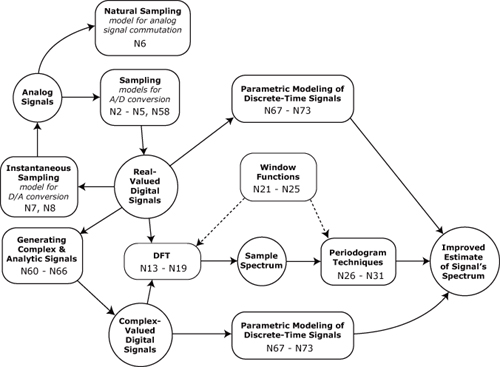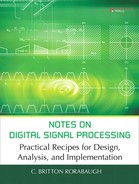Note 1. Navigating the DSP Landscape
Digital signal processing (DSP) is based on the notions that an analog signal can be digitized and that mathematical operations can effectively take the place of (or even surpass) electronic manipulations performed on the original analog signal. In the earliest days of DSP, its applications were limited to sonar and seismology because these fields utilized low-bandwidth signals that could be sampled at adequate rates using the available technology. As digital processing circuits and analog-to-digital converters have become faster and faster, the number of applications for DSP has exploded.
Hundreds of techniques (and variations thereof) are used in DSP, and it can be difficult to see the big picture—how all these various techniques relate to each other and to a particular application at hand. Rather than a comprehensive treatment of all the possible topics within DSP, this book is an attempt to document in-depth explorations of some of the “nooks and crannies” in DSP that often are glossed over in traditional texts. Figures 1.1 and 1.2 show diagramatically the realtionships among the various processing techniques explored in this book. The topic areas are arbitrarily split into two groups for organizational purposes. Figure 1.1 shows those techniques that are concerned primarily with operating on real-valued digital signals to modify in some way the properties of those signals while leaving their fundamental real-valued and digital natures intact. Given that complex-valued signals are really just quadrature pairs of real-valued signals, most of these techniques are easily extended to corresponding complex cases. Figure 1.2 shows those techniques that are concerned primarily with conversion between real-valued digital signals and other entities such as analog signals, complex-valued signals, and spectrum estimates.
Figure 1.1. Processing techniques that modify the properties of real-valued digital signals. The numbers “Nnn” indicate the Notes in which each technique is discussed. Solid paths indicate “run-time” data connections. Dashed paths indicate “design-time” connections.

Figure 1.2. Processing techniques that convert real-valued digital signals to or from other things such as analog signals, complex-valued digital signals, or spectral estimates. The numbers “Nnn” indicate the Notes in which each technique is discussed. Solid paths indicate “run-time” data connections. Dashed paths indicate “design-time” connections.

